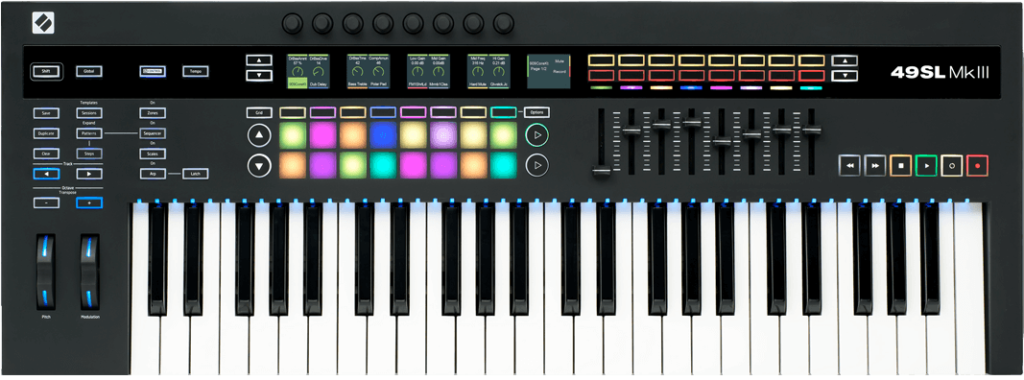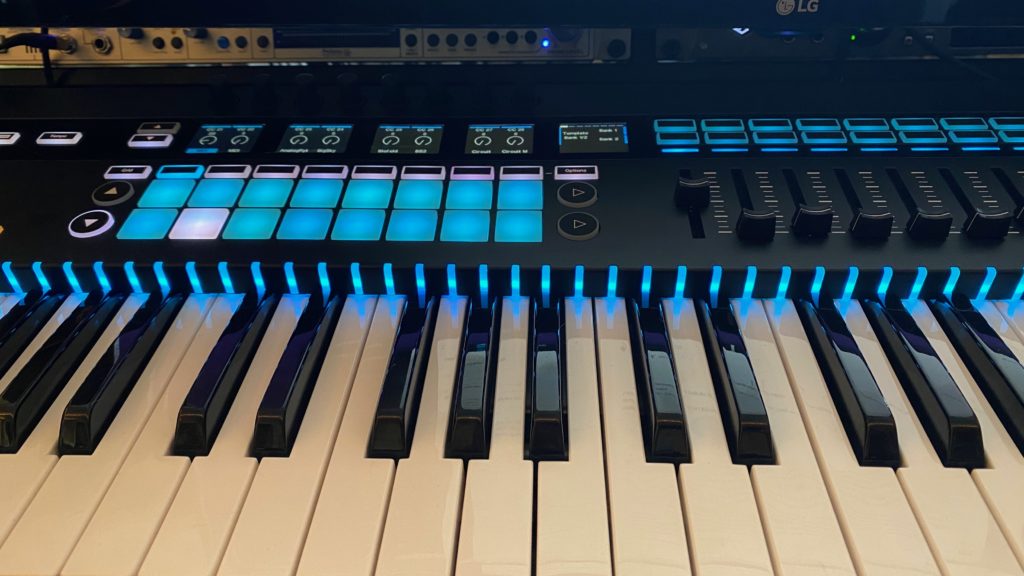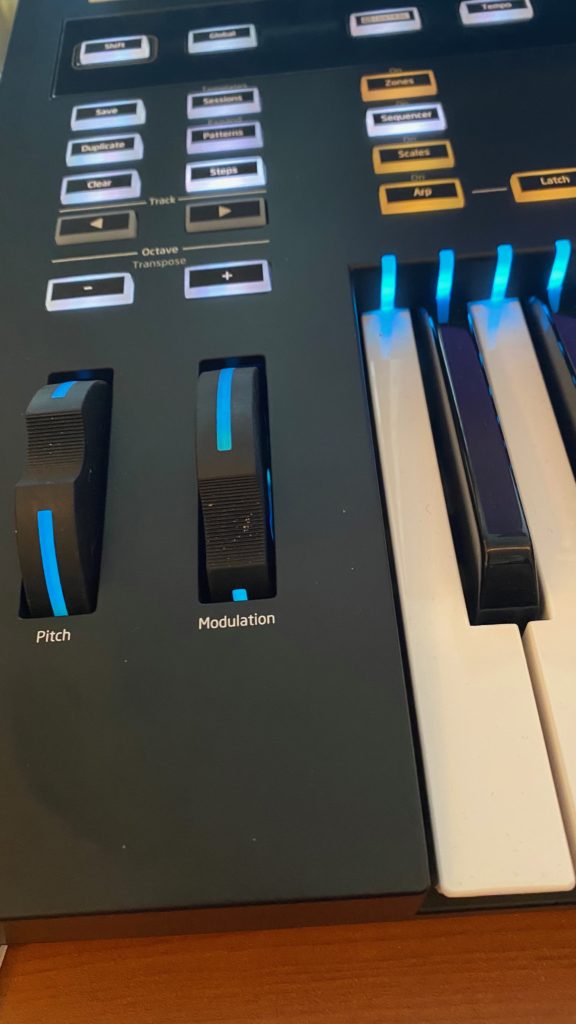Thanks very much to Leon and the Auckland Rock Shops for supplying this review model.

I have been using an older Novation 49SL MkII MIDI controller keyboard for years both in the studio and on the road, and despite still being rock solid play-wise, the continual abuse was finally starting to take its toll. The USB port was getting a little sloppy, and the joystick was getting so physically worn it wouldn’t reliably center anymore, despite an attempt at cleaning the pots. I was also a little over the weirdness of the Automap app that came with the Novation to allow integration into DAWs – it was very powerful, but I found it too complex to use in day to day studio applications and it was also prone to causing its own issues due to it’s complexity with wrapping plugins and the extra layer of abstraction. Or maybe it was just me.
Regardless, I had been looking towards purchasing another keyboard controller, with the following thoughts in mind:
I wanted to get another nice-feeling key bed. Some of the cheap keyboards feel too light. I wanted aftertouch – most of the mid-price-range controllers don’t have this feature, and it’s very useful at times. I wanted more than 49 keys but not a full 88 notes. I wanted some simple programmability to split and map the keyboard for live use. And I wanted a brand I knew to be reliable and well-built, ideally with a solid and reliable fast-scanned key-bed and semi-weighted keys.
I’ve used many other MIDI keyboards through my teaching job, and many were quite good, but apart from most having a cheaper feeling keyboard and sometimes a certain “flex” to the chassis, they usually also wore out quickly – especially the pitch-bend controller. I also wanted more trigger pads than the old keyboard, with both Ableton and the new Logic Live Loops compatibility. So in browsing the available products there seemed to be many choices, but there always appeared to be missing features.
Then I spotted the new Novation SL MkIII. I wasn’t sure I liked the look of it at first – a fairly typical black plastic boxy-looking thing, compared with the more sleek and attractive older silver and black MkII model. It had the separate pitch bend and modulation wheels compared with the single joystick that I’d become used to, but from prior experience this meant it was easier to service so I was cool with that. It had more buttons and pads but less knobs than the old model, but to be honest I never used all of them anyway. Also gone was the square touch pad controller, which I rarely used but made a great guitar pick holder in the studio.
I spent a bit of time checking out the available promo videos on the Mk III. The features actually looked pretty cool – way more than what I thought I might need, to be honest. They really had designed it to be a performance-based keyboard at the center of a setup, with built-in sequencing and arpeggiator features and multiple zone splits. And dual CV/gate/mod outputs and a clock for controlling modular synths. I’d been avoiding that modular money trap, but maybe one day…
First impressions. Well-packaged and quite solid. Does not feel plasticky and does not flex like some cheap units. A little heavier than my old keyboard, but not that much.
A rubberised strip running right around the base of the keyboard makes it grippy regardless of whatever type of stand you use. My old keyboard used to slide around on the stands all the time. Sometimes the simple things are a winner and this simple little feature is amazing.

The MkIII needs a separate power supply which my old MkII didn’t need – that one could run on USB power only. One more wall-wart to find a space for. Sacrifices must be made for all the extra features I guess.
OMG – it’s like a light-show when you plug it in. Nothing can prepare you for the LED splendor of this device. It’s almost a bit much. But – it’s very useful stuff to give you feedback on modes/zones and all that. There’s been a lot of thought gone into this visual feedback system.
There’s a RGB LED above every key that is coloured to indicate the key zones (there’s just one zone initially) and each LED brightens when you play the associated key. Oh – and if you stop playing for a bit, it goes into a kind of screen-saver mode, with scanning colours going across all the LED’s in a wave. Very relaxing. It wakes instantly when you touch anything though.

There’s five little square TFT colour displays that show detailed information such as knob positions and mappings and various menu selections. Each is under a pair of the 8 continuous rotary knobs at the top with an extra TFT set to the right for extra info and context. The knobs feel very smooth but are unlit and black and hard to locate under dim lighting.
The rubbery RGB backlit buttons have a really good feel and take a bit of definite pressure to obtain a click.
The 16 trigger pads are very responsive indeed (and have colour feedback to display strike velocity) plus they include aftertouch as well. Very nice.
The 8 faders are long-travel and feel very smooth with just the right amount of resistance to imply quality.
There’s 6 dedicated transport buttons for DAW and in-built sequencer control – I like this. My old MkII shared them with other functions so you had to be careful to be in the correct mode for them to work.
Pitch-bend and modulation wheels are smooth, and the pitch-bend is well-sprung and centers accurately. They have LED strips that brighten as you turn them, and change colour to match the zones they are controlling.

The keyboard feels very good and it’s very fast and responsive. It apparently has a 10kHz scanning rate for the keyboard which is fast compared to most other keyboards. It certainly feels more responsive than some other controllers I’ve used. You have to press quite hard to get the aftertouch switching in though. You can set velocity curves for the keyboard.
Overall layout of the controls is good for typical use between simultaneous playing on the keyboard with one hand and tweaking with the other hand, even though visually it feels a bit left-biased.
Connectivity. When you plug the keyboard into your computer via the USB cable, and then open a browser window to the Novation website (not on Firefox – but Chrome works fine), and then log-in, it can communicate directly to the keyboard. This is like magic to me. They call this area of their site Components and it’s like a library of templates and configurations you can send and receive from the keyboard. You can also update the firmware directly from the web page, so I did this first. It was almost too easy compared to the usual fiddling with USB sticks and the like. In this Components area you can build your own custom configurations and re-map every hardware control on the keyboard if you wish. There are also many ready-made templates for hardware synths. You can even calibrate your pitch-bend and modulation wheels online.
The keyboard integrates quite closely with a couple of DAWs – Ableton Live is the deepest I think, followed by Logic Pro X. Other DAWs have various levels of integration, or at the least just the Mackie HUI and controller connections. My main DAW is Logic Pro X, and with the latest v10.5.1 update I was hoping that the Novation pads would easily trigger the new Live Loops, with integration similar to triggering Ableton clips. Unfortunately not yet. I’m guessing it’s too soon, so it will be interesting to see if and how quickly Novation adds additional implementation for this.
With Logic Pro X, you need to install a Novation’s control surface plugin to get full implementation. This replaces the old AutoMap Server app which was finicky and personally caused me all sorts of issues over the years so it was nice to see something more graceful in place. Once i got the new Novation plugin successfully installed it seemed to work fine. It showed up in Logic’s Control Surface setup, and the transport controls and faders worked, but I still had to do a bit of troubleshooting to get the Novation TFTs displaying the correct Logic info – especially the Smart Controls. So I had to trash the old Logic Pro X control surface preferences and reinstall the plugin. No biggie. After that it worked like a dream. You just need to press the “In Control” button on the Novation to make it happen.
Hardware-connectivity-wise, there’s pretty much everything you’d need on the back: Three MIDI DIN plugs: In, Out, and a selectable Out2/Thru. There are two sets of CV, Gate and Modulation outputs (configurable to 0-5v, or -5 to +5V) on 3.5mm jack sockets, and a single clock out. Three sets of ¼” pedal input sockets complete the array – with two being for Sustain and Expression pedals and the other one for Footswitch. And of course the USB 2.0 and power sockets.

Sequencer:
Although, as I mentioned, I didn’t really play with this function very much (despite it being a major selling-point), for the sake of completeness I should at least let you know what it does.
There are 8 sequencer tracks (parts) that you can use to capture real-time or step-based MIDI performances on. For example, MIDI notes, with velocity and automation. You can have 8 patterns per part. There are 64 Sessions each containing 8 parts though – so that gives you plenty of scope for a live performance. You can have up to 32 steps per pattern and can edit the timing to a higher resolution within each step. There’s quantising and swing features. All assignable controls can be automated up to maximum of 8 at a time. You can chain patterns. On the down side, the 16 pads are not quite enough to visualise a full arrangement at any one time as they need to be banked, despite being able to “rotate” the pad display view vertically or horizontally. Oh and you can change direction of the patterns, or make them random. And you can shift a pattern left or right.
Scales:
This is a pretty funky feature. You can apply one of 16 selectable scale types to the keyboard and then choose whether to just display it via the little key LEDs, or snap non-scale notes to the nearest scale note, or just ignore (mute) them.
Zones:
You can split the keyboard into up to 8 different zones (they can overlap as well) with a different MIDI output channel or sequencer track. Each is lit with a different colour on the key LEDs. You can map the Pitch-bend and Modulation wheels to any zone and they will also match the LED colour of that zone.
Arpeggiators:
One arpeggiator per sequencer track. There are some interesting features available for this. Unlike a regular arpeggiator, you can customise the played notes in the arpeggio by turning them on or off via the pads. There are the usual features as well, arp type, direction, sync rate, length etc. Quite nice.
Using the features. I always like to see how intuitive the setup is to use by just having a play. To be honest I struggled a bit – I could see there were buttons labeled eg Zones, Sequencer, Scales and Arp, but pressing them doesn’t necessarily activate those features. It often just allows you to edit the settings for that feature. You have to actually hold the “Shift” button and press one of the other buttons to do that. Most systems would flip it the other way around. But it all works well once you get your head around the architecture of the system, and is not as tricky as it seems after a little use. I never got to try the CV outs at all, and barely touched the inbuilt sequencer or arpeggiators as I use a DAW for that – but I’d like to play with them more – the additional features look great. There’s a bunch of good videos on the Novation site for these features if you want to know more about them.
Live performance. I decided to use the keyboard for an upcoming post-Covid19 Lockdown gig using Apple’s MainStage. Due to the short preparation time, I only used the basic features of the Novation (mapped controls and keyboard splits) but it was certainly impressive on stage, both in look and feel. The keyboard LEDs provided sufficient light to be able to see what I was playing despite the very low-light conditions – and those of you who have performed live on-stage will know how dark it gets when the lights are turned off on stage!Apart from the keyboard I only mapped the faders and a few of the buttons, so it was easy enough to find them.And the solidity and grip of the keyboard made it a pleasure to play live.
Positives:
- The built-in sequencer and arpeggiators are fantastic.
- Scales mode is cool.
- Excellent colour-indicated keyboard split zones.
- Lights! Lights everywhere!
- The pads are beautifully sensitive.
- Dual CV outs for the hardware junkies.
- All the MIDI options – full set of DIN plugs plus USB.
- Good-feeling responsive keyboard.
- Works extremely well with Ableton and Logic as a control surface and still quite good with other DAWs through the Mackie HUI mode.
- Good web-based system for updating firmware and customising sessions and patterns etc.
Negatives.
- I miss having LED rings under the knobs.
- I wish you could program your own custom scales.
- Not USB-powered (unsurprisingly).
- Not quite enough pads to easily navigate an entire Sequencer arrangement.
Summary.
Although at first glance it doesn’t stand out that much from the current range of keyboards, mostly by being standard matt-black, this MIDI keyboard controller is a monster. One of the advantages to developing newer versions of a product is that it’s a chance to optimise, and they certainly have with this one. They’ve kept all the good stuff and added to it, and dropped the less-used features. It’s got almost everything you could possibly need and more – and they keep adding and refining features via the fairly regular firmware updates – in fact they recently increased the single arpeggiator to one per each of the 8 sequencer tracks, and also increased the quantisation resolution of the sequencer. In this price point you’ll see a lot of features that are missing from other brands – like the full set of hardware plugs and aftertouch. Novation have really established themselves as one of the better brands by not cheaping-out and dropping quality. I loved this keyboard so much I actually bought the review model. This is an excellent keyboard controller for those who want both quality and features without selling the house, in a gig-ready box. Recommended.
